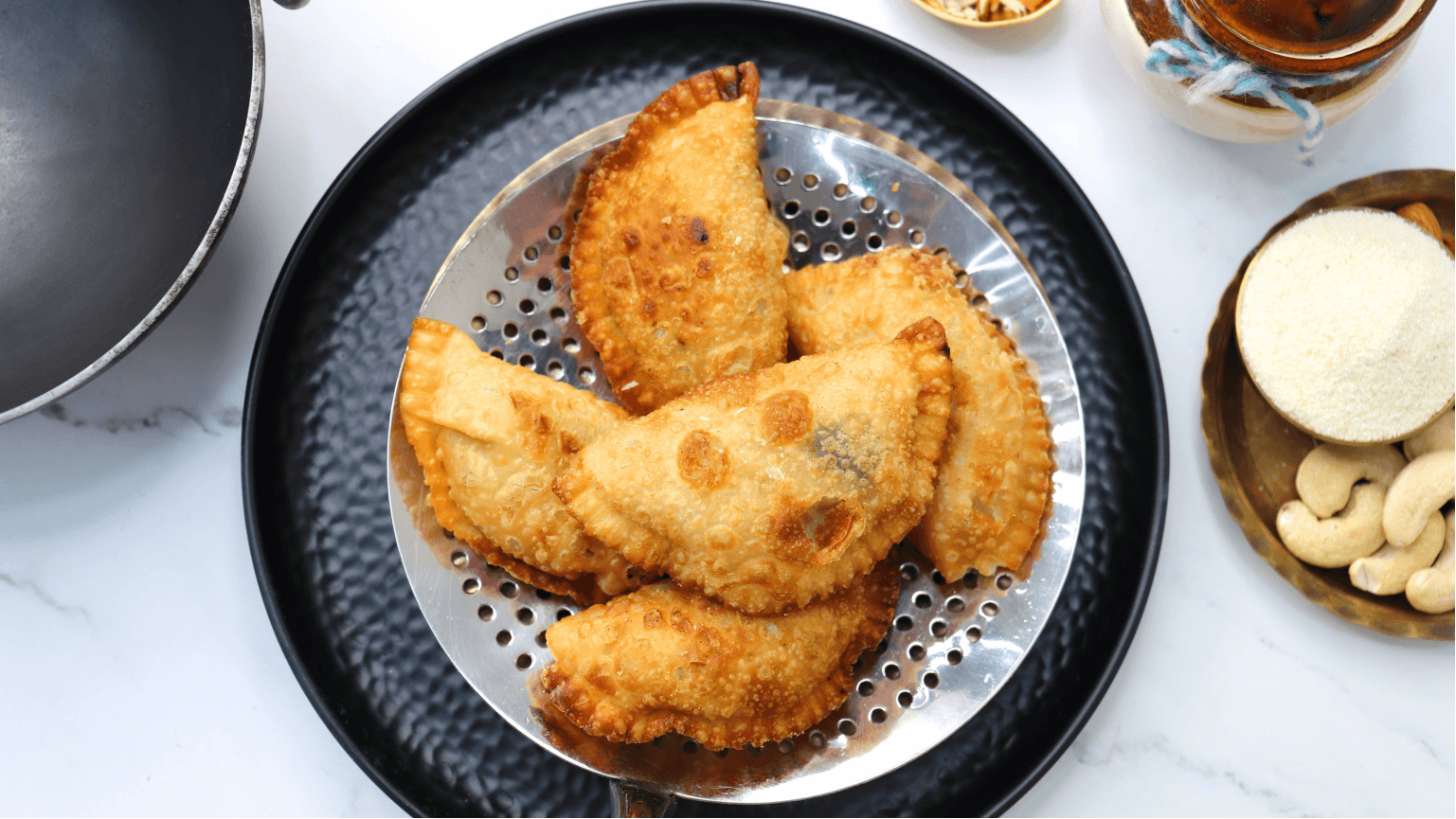Karanji is a popular sweet from the Maharashtrian cuisine, is an indispensable part of Deepawali’s festive snacks. Filled with cooling coconut, these half-moon fried pastries are universally loved. In North India, a Karanji variant is called Gujiya and in Gujarat they are popular as Ghughra.
The recipe, with its nourishing benefits, has been praised in the Ayurvedic manuscripts, Nighantu Ratnakar as below:
Dhatu-vruddhikaro Vrush’yo Hrudyashcha Madhuro Guruhu |
Saarako Bhagna-sandhaana-kaarakaha PittaVatahrut ||
This means, “Nurturing and nourishing all body dhatus (tissues), Sanyaav (the Ayurvedic name for Karanji) are beneficial for the heart, deliciously sweet, increase potency (shukravardhak), are a rasayan (tonic) and facilitate good bowel cleaning. They are especially helpful in healing and repair of fractured bones. Karanji pacifies the pitta and vata doshas.”
If made properly and with good ingredients this festive sweet can be consumed at home as a family health tonic, all year round.
In Karanji, maida (fine wheat flour) is the commonly used flour for the dough. However, at Santulan we make our best efforts to create delicious recipes without compromising on health. In this recipe we have used suji/rava (semolina), which is also made from wheat but is not as processed and has greater nutritional value. The added advantage of suji or rava is that Karanjis turn out even more crispy and crunchy.
Preparation time: approx. 45 min
Serves approx.: 25-30 pieces depending on the size of the karanji you make.
INGREDIENTS
For the dough:
- Suiji (Semolina) – 360 gms
- Ayurvedic ghee, heated – 40ml
- Milk – 100ml
For karanji filling:
- Coconut – Fresh & grated – 250 gms
- Sugar – 360 gms
- Elaichi powder – 2 gms
- Saffron (as per taste) – pinch
- Ghee for frying – 300 gms
PREPARATION
Preparing the dough:
- Heat the ghee in a thick pan on a medium flame.
- Take the suji in a deep bowl or pan and make a small well in the centre of the suji. Pour the heated ghee into the well. Mix using fingers and knead while adding milk gradually. Prepare a slightly hard dough.
Preparing the filling:
- Roast the grated coconut for 2 mins. Add sugar and cook for 20 – 30 mins on a low flame till it is thick in consistency and binds well together. Keep stirring during the cooking process. Finally, add the aromatic saffron and elaichi towards the end.
- Form little balls from the dough and roll into circular puris of 3-4 inches diameter. While rolling one ball, keep the other balls covered with a moist cloth.
- Place 2 – 3 tsp of the coconut filling in the centre of the puri and keep the edges empty. Avoid adding too much of the filling as it can be difficult to shape them and the Karanji may break while frying.
- With your fingertips, apply water all around the edges. Carefully bring both edges together over the filling and join to make a beautiful half-moon shape. Gently press the edges. Now with your fingertips start pinching and pleating the pressed edges neatly. Alternatively, one can use a pastry cutter for the same.
- In the pan, heat up the ghee for frying at medium heat. Gently place the Karanji in it to deep fry. Add only a few Karanjis at a time depending on the size of the pan. The Karanjis will puff up while frying. Fry on medium heat till they are crisp and golden brown on both sides. Remove carefully and drain them on paper towels to remove excess ghee.
The delicious half-moon shaped sweet, Karanji is ready. They can be served hot or cold. They remain fresh for 2 – 3 days when stored in an airtight jar. The mouth-watering Karanji is sure to bring a smile on the faces of your family and friends any time you make it!
Happy Deepawali!
